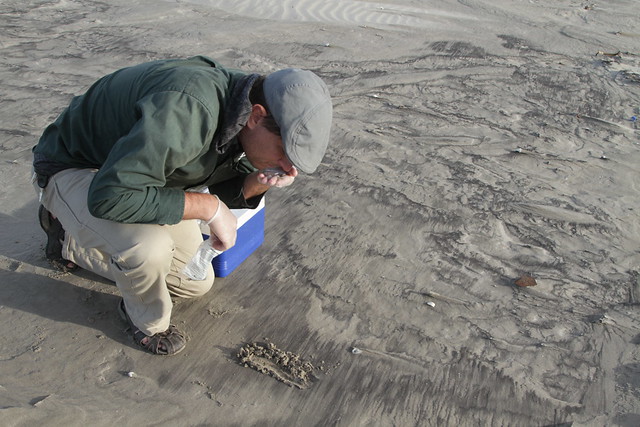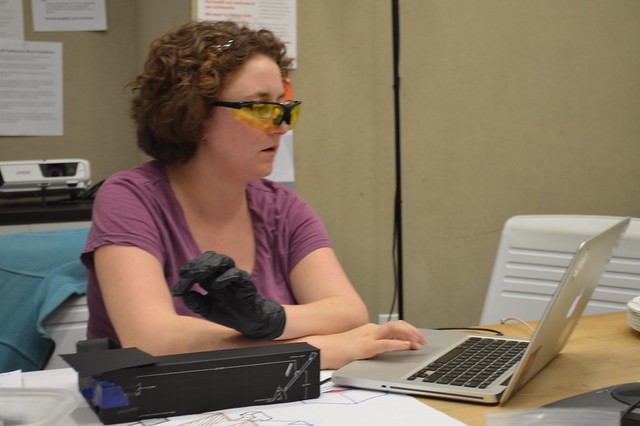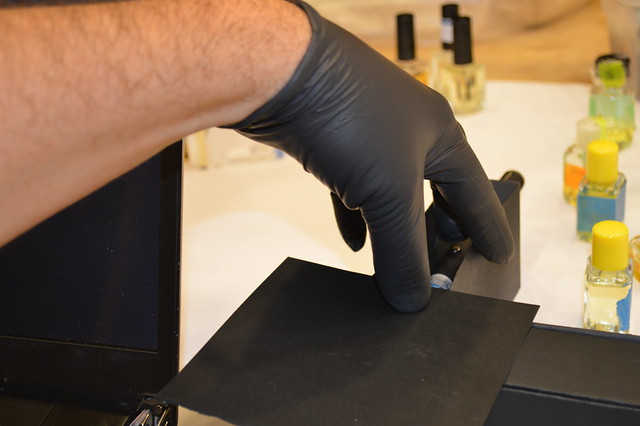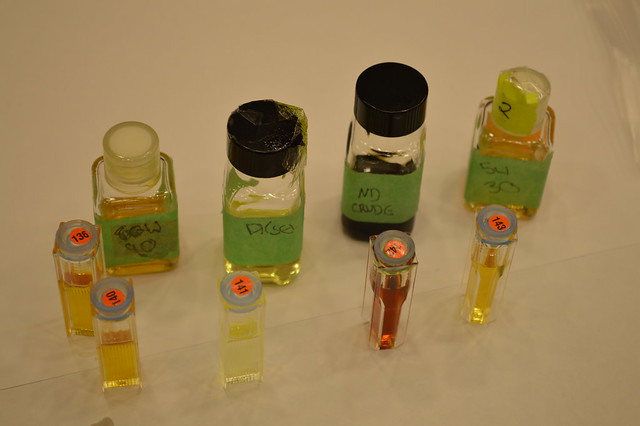What I want to do
This is my entry into the oil testing beta program--the sampling! I also want to include the Grand Isle coffee that Team Orca (RIP? undead?) collected in 2013. The GRN continues to hold Tarball samples taken from Louisiana and Mississippi Islands from 2010 to 2015. Matej has expressed an interest, so now I have to figure out how to mail such things.
The third iteration of the spectrometer really does resolve so many of the variables that made the initial spectroscopy of Grand Isle coffee so difficult for me. Kudos to the Spectral Workbench team for:
1) introducing the UV laser (after the original fluorescent lamp and green laser)
2) refining the 'box' from the conduit to the papercraft
2a) making the setup light tight
2b) greatly simplifying the alignment problem
3) improving the camera
4) settling on the square cuvettes
I was easily able to integrate my previous samples, kept in a cooler at room temp for a couple years, into the Beta testing system. Team Orca had an array of equipment for sampling and keeping tar balls in the field, which include:
1) small cooler with lasers
2) a number of pre-labeled glass jars (EPA brown glass or bell / mason jars)
3) nitrite gloves and ziploc bags for cleanliness
4) kitchen gloves for goop
5) a larger cooler or long term storage indoors
6) a larger cooler for transport of oil testing materials with previous samples (plus mineral oil, etc)
some of which is pictured here:

My attempt and results
I was used one of Stevie's Favorite Spectrometers, version 3.0. this worked well, although there were occasionally some echoes in some of the fluoresence signals into the 860+ nm wavelengths.
We followed the instructions on the oil testing beta page, which the exclusion of smoothing the curves. I may try a second iteration of these data with curve smoothing.
After mastering the one-glove-laser-and-cover technique (here demonstrated by DD), I was up and running in no time.
Mineral Oil Control (s2915)

Diesel (v141) (s2924)

8w90 (v140) (s2919)

20w30 (v138) (s2921)

5w30 (v143) (s2926)

ND Crude (v142) (s2928)

Brake Fluid (s2944)

Grand Isle Coffee x10 dilution (s2937)

Grand Isle Coffee x100 dilution (s2939)

Unknown random sample from previous list (s2930)

I had thought that the unknown sample looked either like the ND Crude or the 5w30, but since the unknown sample didn't stink like the ND Crude, I assumed it was the 5w30. Stevie thought this was cheating; I call it ancillary information. I'm still trying to figure out how to compare the ND Crude to the Grand Isle Tar--although when i hit "find similar", spectral workbench found Ethan's ND Crude samples matched my Grand Isle samples (s2950). strange.
The intuitive smell test remains a critical component of Team Orca's repetoire As a field test, it's hard to beat. The nose knows--even one as terrible as mine, which has been numbed with a march of sinus infection problems that renders my smell and taste senses rather insensitive.

Questions and next steps
The cross-handed motion of running the laser while typing on the computer was a complicated motion. DD and DFlores both discussed the fact that oil spill testing was easier with two people--one to hit the laser, and one to type and click "save." It's also kind of gross; inevitably, oil goop gets on your keyboard.

The black cover over the vial / cuvette was helpful for reducing noise in the spectra, but also necessitated a complicated hand position.

I have one example of a dilution--The Grand Isle Coffee is an informal 1x (half tar ball, ~half mineral oil) 10x (~ten times the mineral oil) and 100x (~ten times the 10x). the samples have different opacities.

Opacity readings?
Here you can visually compare the different opacities of different samples:

And here you can see the differences opacity of the different dilutions of Grand Isle Coffee. Not sure how to measure this with the spectrometer, although Ethan said we could.

Tar Balls over time?
Team Orca has over 30 jars of tar from 2010 to 2015. Do the spectra from what are presumably all Macondo tar balls appear different over time? Can we assume these are all Light Sweet Louisiana crude, or all from the same source?
Tar Sources? Can the Spectrometer tell different Crude oils apart?
Ed Overton at LSU studied tar balls in Louisiana and discovered 66 sources from less than 120 samples, based on Gas Chromatography / Mass Spectrometry. Could the spec distinguish "light and tight" Bakken crude Heavy Venezuelan tar or from "Light Sweet" Louisiana crude? Doing so would help distinguish tar balls from production spills vs transport spills.
Remediation?
What do I do with all these tar balls GRN has accumulated over 5 years? Would it be practical to develop a mycelial oil remediation kit to go along with the oil test kit, a la the Formaldehyde sensor kit?
Why I'm interested
Team Orca lives.. We will continue to experience tar balls washing up in Louisiana, Mississippi, and Louisiana. I will post my field kit and NRC procedures in later notes.

3 Comments
Fantastic and entertaining write-up @eustatic -- thanks all!
Reply to this comment...
Log in to comment
Scott, I'd be really interested if you collected a set of a bunch of different tar ball spectra, esp. in different states of decay/weathering, to see how consistent they are. For example, multiple scans of the same sample at the same dilution, as you've done above, look pretty consistent. Is it possible to just collect a whole bunch of tar ball scans you've already done and add them to a single set?
Thanks, Scott, this is great!
Is this a question? Click here to post it to the Questions page.
Reply to this comment...
Log in to comment
I owe Matej samples. Stevie gave me some brown jars, so i can divide the bulk samples and mail them to him. then, we can zap them independently!
S
Reply to this comment...
Log in to comment
Login to comment.